Architecture of Split, Dalmatia, Croatia
UNESCO Sites in Split: Historic Center and Palace of Diocletian
Must-See Sites in Split: Palace of Diocletian, Saint Domnius Cathedral, Riva Waterfront
Overview
I can’t think of any other city on earth that was founded the way Split, Croatia was. The historic core of the city is actually the remnants of the Palace of Diocletian. The modern street plan of the city still reflects the original walls, rooms, and hallways of the palace 1700 years later. Diocletian’s Palace and the overall culture of Ancient Rome would be the biggest influence in the architecture of Split.
Although there was a small settlement in the area before the palace was built called Spalatum, the vast majority of Split’s history from the days of the Roman Empire to about the 15th century revolves completely around Diocletian’s Palace.
Today, like just about any other European City, Split has expanded far beyond the protection of its medieval fortifications. Split is currently the second-largest city in Croatia and is an important commercial and cultural hub on Croatia’s Dalmatian Coast.
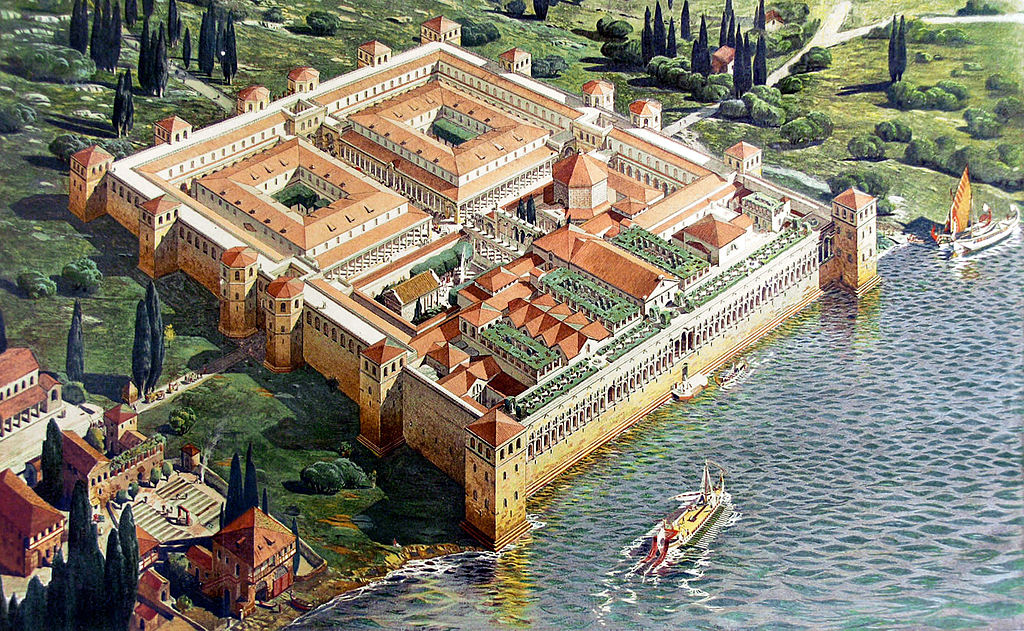
Image from the Public Domain
Creation of the Palace of Diocletian
Very few Roman Emperors abdicated the throne. Far more were either overthrown or held on to their power until their final days. One notable exception to this was the Roman Emperor Diocletian. Diocletian reigned over a relatively unstable Roman Empire, and he worked tirelessly to return Ancient Rome to its former glory.
Most historians agree he was predominantly successful. Diocletian ruled from 284 to 305 CE but continued to live on until his death in 311 CE at the age of 66. Diocletian, a native to the region of Dalmatia in modern-day Croatia, built a massive fortified palace to use as his personal residence for his retirement. He spent his golden years, or his aurea annis, relaxing in his seaside palace overlooking the clear blue waters of the Adriatic Sea.
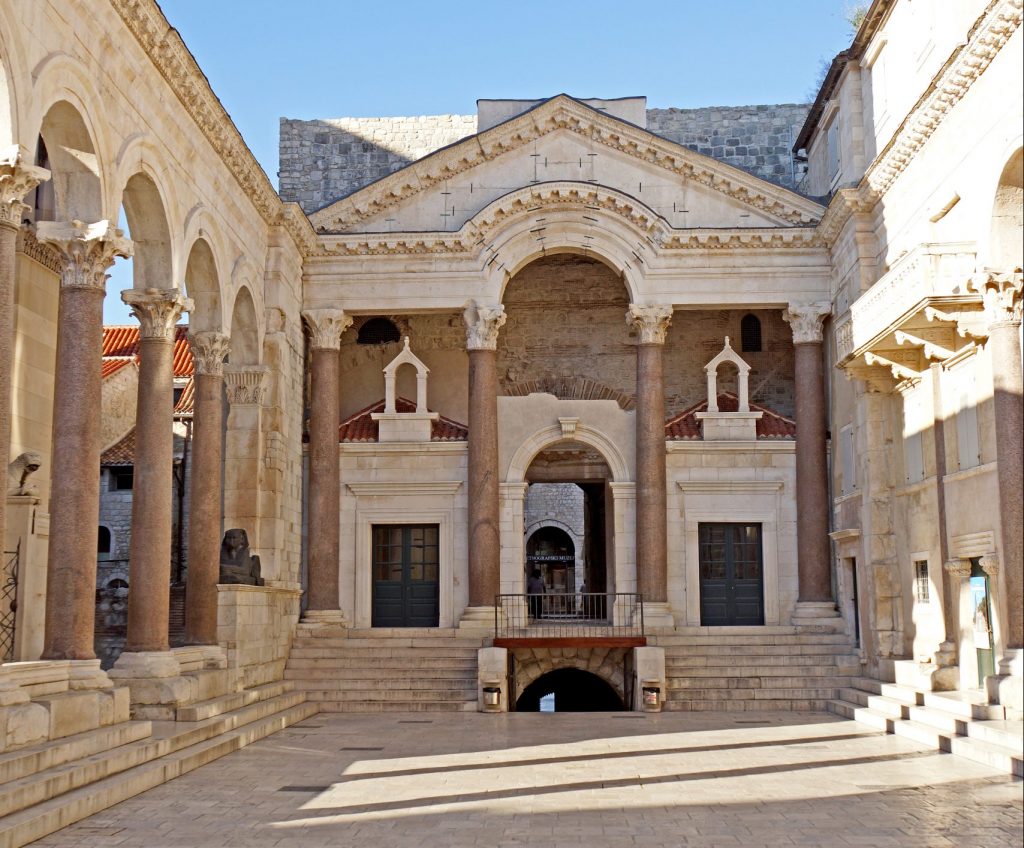
Photo by Dennis Jarvis from Wikimedia Commons
(architectureofcities.com cropped this image)
The palace itself was a massive building encompassing over 400,000 square feet. (37,000 square meters) The overall plan of the palace was a rectangle with heavy stone walls on all sides and 16 defensive towers located along the perimeter. Each wall had a large gateway at the center which aligned with streets that crossed through the palace grounds. The most decorative façade was on the Southside facing the ocean. All of these features can still be seen within Split’s modern-day street plan. Even the small narrow streets within the city center can be traced back to the stone hallways that were once walked by Diocletian himself.

Photo by dronepicr from Wikimedia Commons
The palace contained many separate elements and structures within the fortifications that were used by both Diocletian and countless other residents including soldiers, government administrators, and servants. There were three separate temples of which only one, the Temple of Jupiter survives. In the heart of the palace, there is a large peristyle hall which contained granite columns and sphinxes that were shipped in from Egypt. Below the palace, there are massive cellar rooms with thick stone pillars and vaulted ceilings.
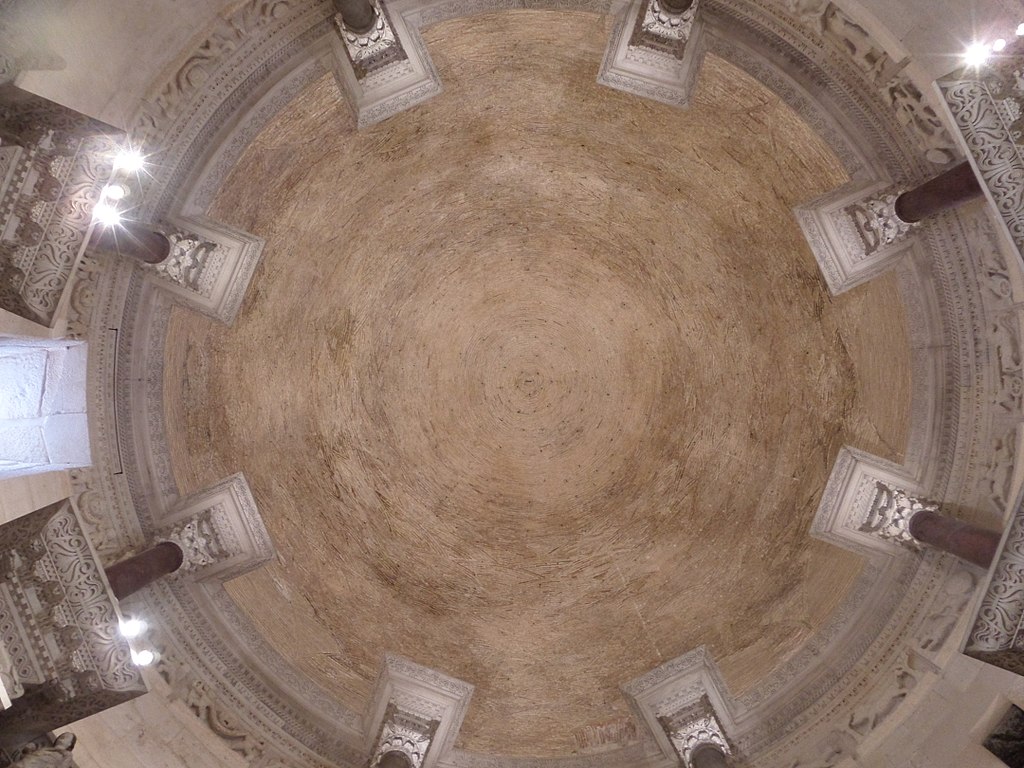
Photo by Gaius Cornelius from Wikimedia Commons
The most notable edifice is the tall domed mausoleum which would later hold Diocletian’s remains. This mausoleum was eventually incorporated into one of Split’s major architectural attractions, Saint Domnius Cathedral. The design matches several other Roman Mausoleums, it has a cylindrical shape and is surrounded by a covered colonnade. Inside there are two tiers of Corinthian Columns and a plethora of ornate carvings and moldings all made out of fine white marble. The mausoleum, as well as the adjacent peristyle hall and Temple of Jupiter, are the three best-preserved works of Roman Architecture within Split. Together, they are regarded as some of the best-preserved Ancient Roman Buildings outside of the Italian Peninsula.
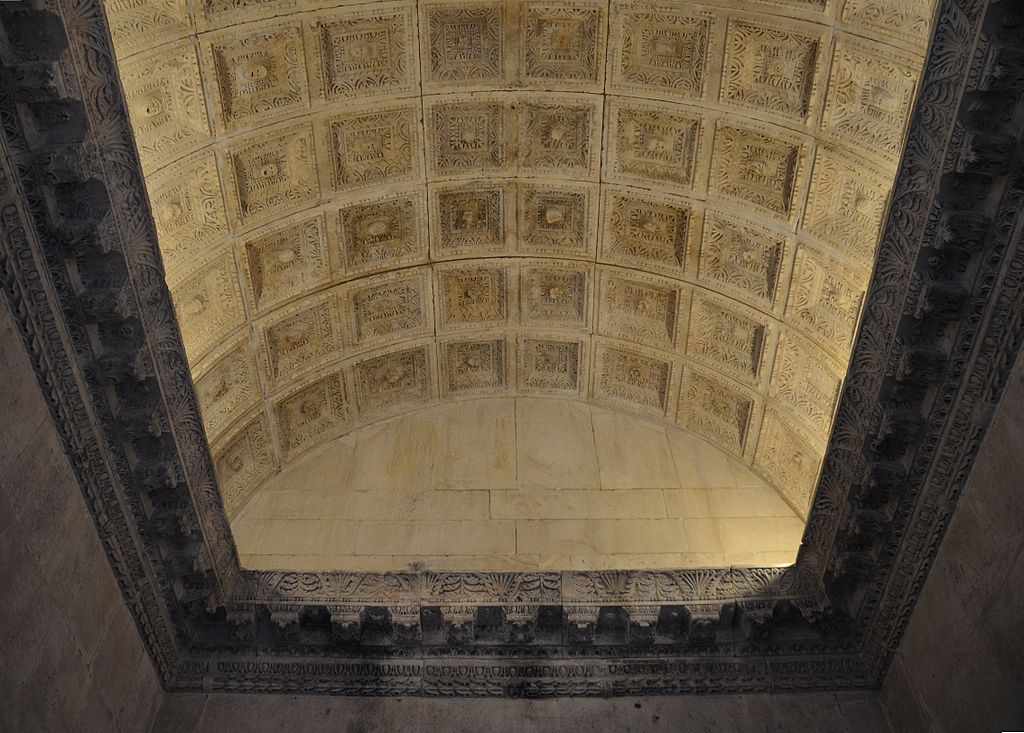
Photo by Carole Raddato from Wikimedia Commons
Fall of the Roman Empire and Early Middle Ages
After the death of Diocletian in 311 CE, the palace remained a possession of the Roman State and was used by various high ranking officials. Eventually, as the Roman Empire slowly collapsed the entire region of Dalmatia faced tumultuous times. There were occasional attacks in the area from the 5th to 7th centuries, and eventually, in 639 CE the Avars completely destroyed Dalmatia’s largest city Salona, located a few miles north of the Palace of Diocletian.
The destruction of Salona was a real turning point for Split and Split’s Architecture. Refugees from the surrounding area began to move within the walls of Diocletian’s Palace, which was easy to defend thanks to its fortifications. Over time these refugees transformed the then 300-year-old building, into more of a fortified town similar to those throughout medieval Europe.

Photo by VitVit from Wikimedia Commons
During this time from the 7th to 11th centuries, the resemblance to the original palace really started to disappear. The Temple of Jupiter was converted into a baptistery dedicated to St. John the Baptist. Diocletian’s Mausoleum was converted into Split’s main religious building, the Cathedral of Saint Domnius. The Cathedral was consecrated in the 7th century, and the now famous bell tower was constructed in the early 12th century.
The bell tower, built in a Romanesque style, is the highest point in the old city center of Split and is the city’s most recognizable landmark. Ironically, the Roman Emperor Diocletian was a very notable persecutor of early Christians, but his final resting place was converted into a Cathedral.
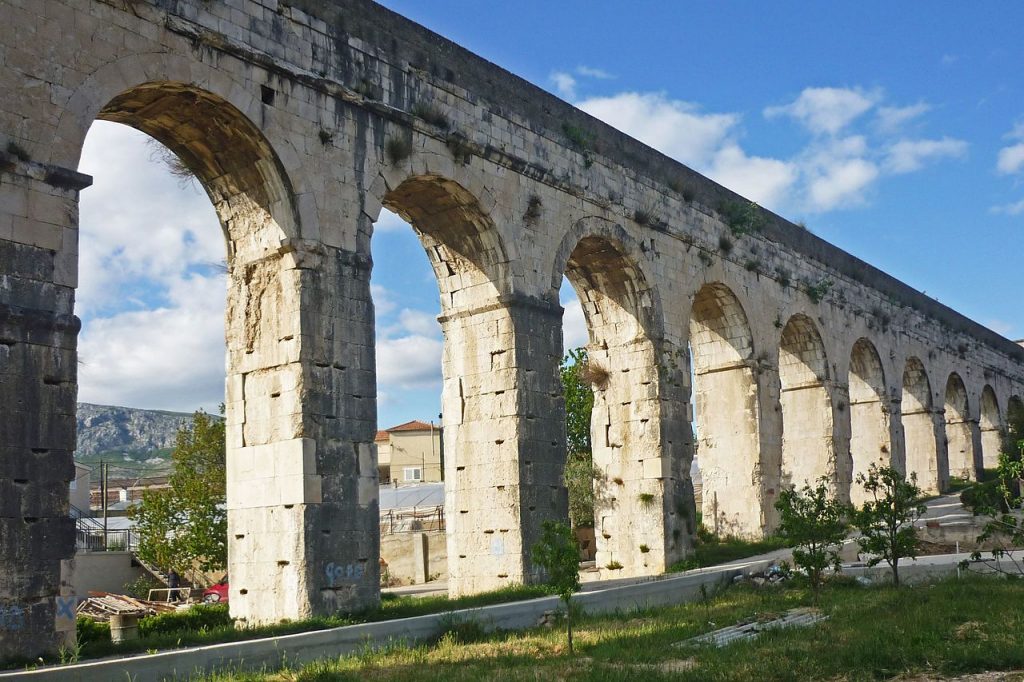

Read our article, “Top 20 Ancient Roman Aqueducts” to see a list of these Ancient Roman Structures and learn more about how important they were to the people of Ancient Rome.
Medieval Architecture in Split
Split and the rest of the Dalmatian Coast were plagued by instability from the 10th to 14th centuries. During that time, the largest powers in the area all jostled for territory, and control of Split was transferred more than 19 times. The Kingdom of Croatia, The Kingdom of Hungary, The Republic of Venice, and the Byzantine Empire all controlled the city at various points, and gave Split various amounts of autonomy.
As is often the case when a region is unstable, not a lot of significant buildings and landmarks were constructed. The population of Split did grow but the town remained confined within the walls of Diocletian’s Palace. Overall, architecturally speaking, this period in Split’s history doesn’t have a ton of influence on the sites within the city today.
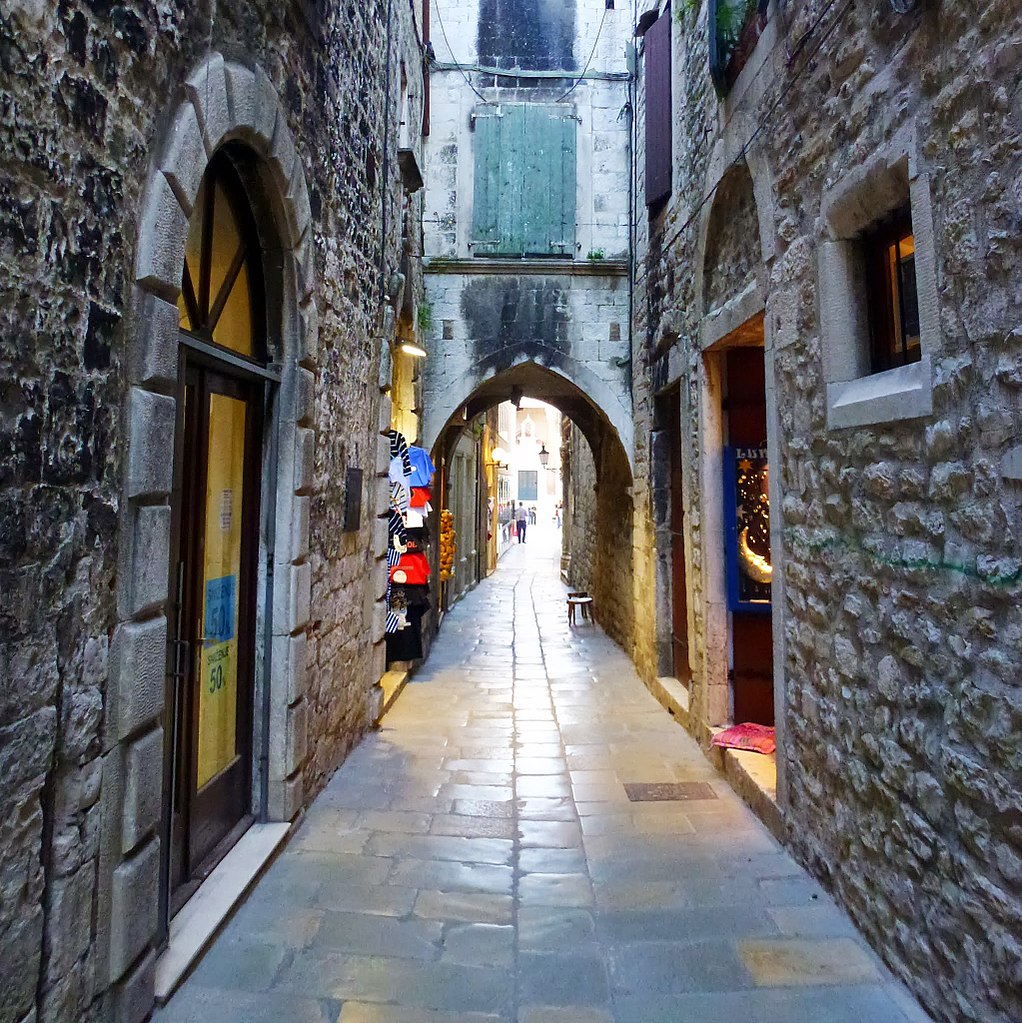
Photo by Николай Максимович from Wikimedia Commons
Venetian Architecture in Split
Although the Republic of Venice reigned over Split before, it wasn’t until they controlled the city for more than 300 consecutive years that they began to invest in major building and infrastructure projects. From 1420 until 1797, the Venetians improved Split’s fortifications, and the city prospered into one of the largest ports in the Adriatic Sea. Just like many other cities located around the Adriatic Sea, the Venetians played an important role in shaping the architecture of Split.
Like Architecture of Cities? Sign up for our mailing list to get updates on our latest articles and other information related to Architectural History.
Stone buildings were finally constructed outside the original footprint of the Palace of Diocletian. The earliest expansion was the area around the modern-day Pjaca, or “People’s Square.” In 1443 a large town hall was constructed on the Northside of the square. The building, built in a distinct Venetian Gothic Style, contains similar elements that are seen throughout the palaces and mansions built in Venice. The pointed gothic arches, loggia, and symmetrical façade are all trademarks of Venetian design from this period.
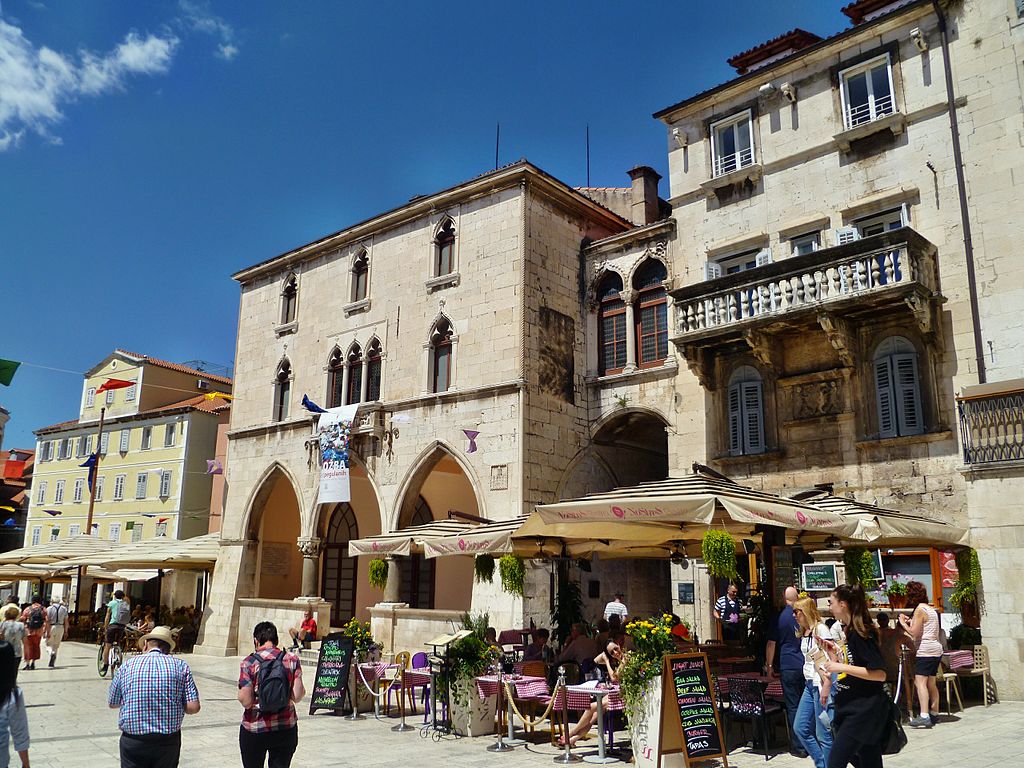
Photo by JoJan from Wikimedia Commons
On the East Side of the People’s Square, directly adjacent to the wall of the palace, is a 15th-century Clock tower. The clock has been continuously running for centuries and is known for being uniquely divided into 24 parts, instead of the standard 12 parts of most clocks. The rest of People’s Square is an elegant jumble of facades dating from the 15th-20th centuries. Many of the city’s wealthy inhabitants built their homes fronting this square and many different architectural styles can be seen.
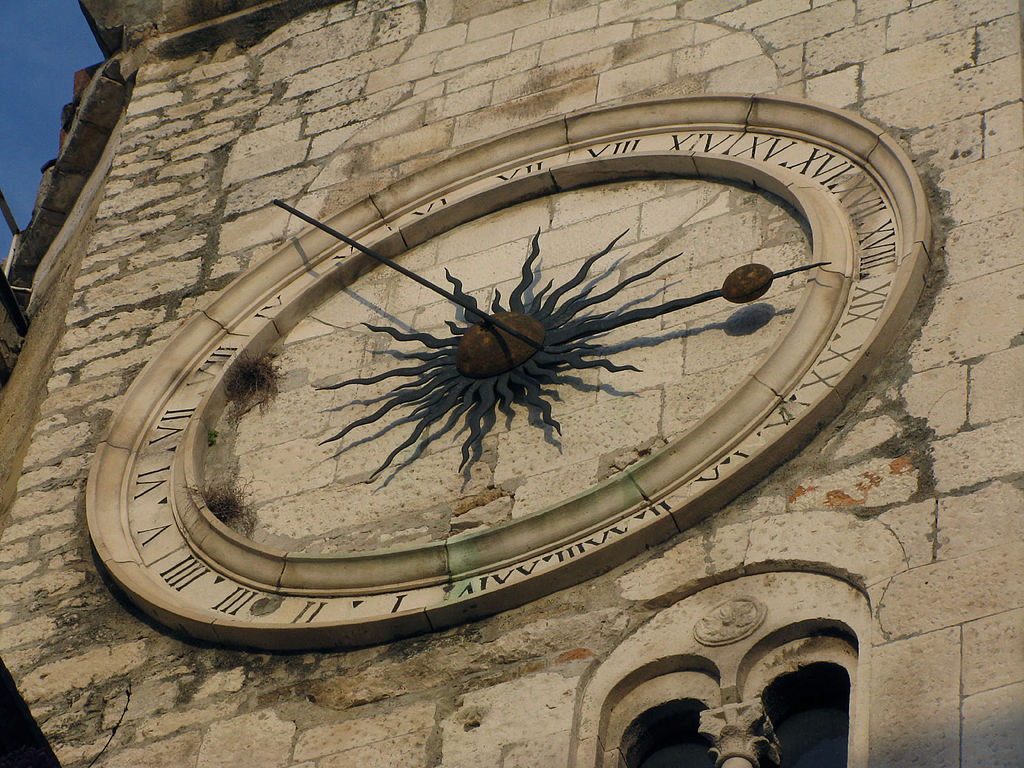
Photo by Ante Perkovic from Wikimedia Commons
The Venetians also greatly improved the cities fortifications. Since they expanded outside the Palace of Diocletian, additional walls and towers were constructed. One of the most notable examples is located in Split’s second most famous plaza, Fruit Square. Named for the fruit vendors which used to sell their goods here, Fruit Square is an open space just off of the waterfront promenade. The square is enclosed by multiple stone buildings that date from various centuries.
The five-story tall octagonal Venetian Tower is located in the Southwest corner of the square, which gives the space a very historic feel. Additionally, the Venetians added more modernized city walls in the 17th century. These ramparts were designed to defend against cannon fire which explains their low and stout design. These ramparts were largely demolished in subsequent centuries, but a large portion of them remain around the Cornaro Rampart, just North of the old city center.
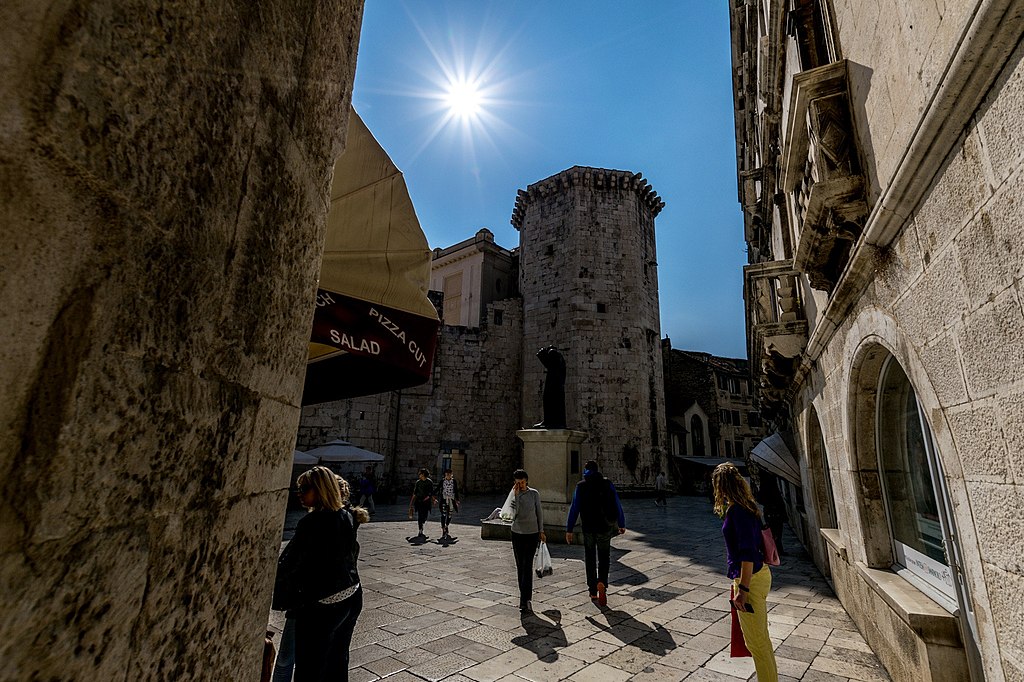
All throughout Split you can find Venetian Architecture and evidence of the Venetian Occupation. The motifs of the Venetian Gothic Style can be found in many of the cities buildings. Sites such as the bell tower of St. Arnir Chapel, Cambi Palace, and Mala Papalićeva Palace, are all constant reminders of the Venetian roots in Split’s modern cityscape.
Napoleonic and Hapsburg Rule
During the Napoleonic Wars of the early 19th century, Split along with the rest of Dalmatia and most of Northern Italy, became part of the growing French Empire. The city’s primary ruler, a man named Auguste de Marmont, created several notable works of architecture within the city. Most notably were the modifications to the Riva Waterfront. The Riva is a wide tree-lined promenade that lines the southern edge of the city.
Today it is often regarded as Split’s greatest public space, and people often joke that it is, “the city’s living room.” The Eastern half of the Riva is fronted by the ornate South façade of Diocletian’s Palace, which is decorated with numerous arches, columns, and niches.
The Western half is fronted by various fanciful buildings all dating from the 19th and 20th centuries. A stroll down the Riva Waterfront is sure to be enjoyable for any visitor to Split. The promenade is a great way to see all of the various stages of Split’s architecture.
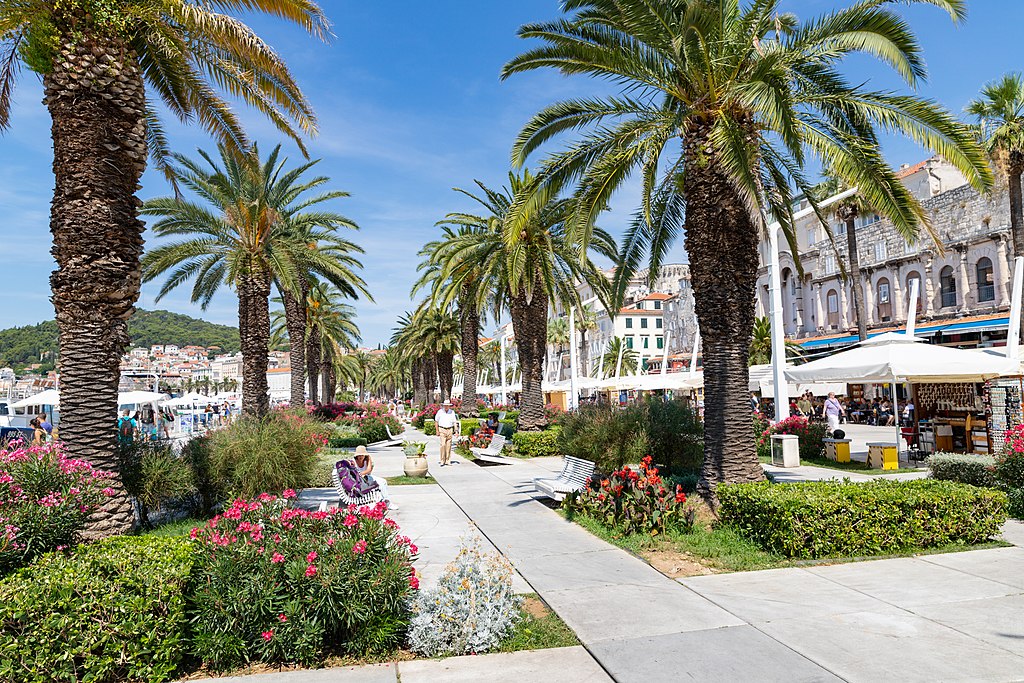
Photo by dronepicr from Wikimedia Commons
The French rulers also commissioned two massive buildings just to the West of the city’s historic center. The Church and Monastery of St. Frane creates a satisfying endpoint to the Riva Promenade. And the Prokurative, or “Republic Square” is a long rectangular square which design resembles that of St. Mark’s Square in Venice.
The long colonnaded buildings with their symmetrical facades were designed to allude to Split’s Italian heritage. One of Split’s most notable commercial streets is located alongside the Eastern face of Republic Square. The avenue, now called Marmont Street, is named for Auguste de Marmont, the 19th-century ruler of Dalmatia that made so many improvements to Split.

Photo by Bengt Nyman from Wikimedia Commons
After Napoleon’s exile, the portion of the French Empire that contained Split was absorbed into the realm of the Hapsburg Family. The Hapsburg’s Kingdom, which later became known as the Austro-Hungarian Empire, controlled much of the Balkans including Split and Dalmatia from the early 19th century until the end of WWI. The Austrians didn’t do a whole lot of building during this time period, and Split’s cityscape was largely stagnant. One notable exception to this was the Croatian National Theater, which opened in 1893.
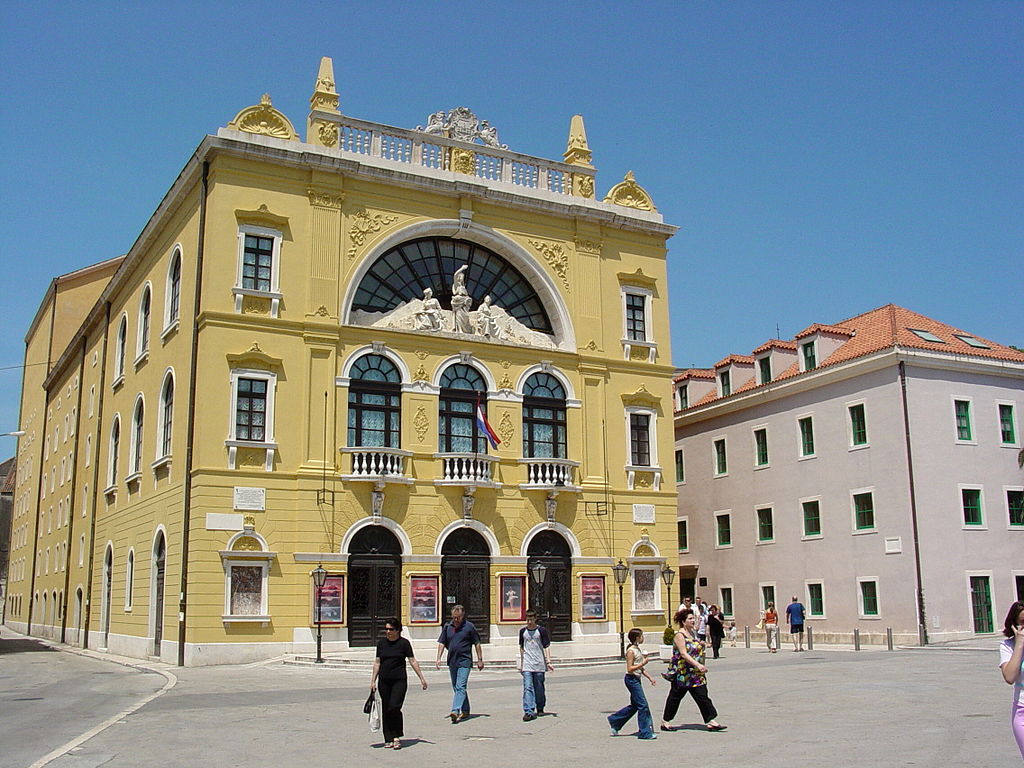
Photo by Adam Jones from Wikimedia Commons
Check out some of our related articles to learn more about architectural history!
Yugoslavia
With the break up of the Austro-Hungarian Empire after WWI, Split became part of the nation of Yugoslavia. During this time the city experienced its largest economic boom. The population of the city nearly tripled, and the suburbs surrounding the historic center grew drastically. Today, Split sprawls for miles outward from the original footprint in and around Diocletian’s Palace. Two of the most notable suburbs are the neighborhoods of Veli Varoš and Lučac which bookend the historic center to the East and West. These neighborhoods are known for still maintaining a sense of historic charm, with many stone and masonry buildings, and cobbled streets. They have a unique atmosphere since they are primarily residential and not overrun with traffic and commercial buildings like what you see on the outskirts of Split.

Luckily, Split’s major architectural attractions survived the carnage of WWII. There were certainly conflicts within the city as it was annexed by Italy, which lead to loss of life and violent altercations. But overall the historic buildings were relatively unscathed compared to the destruction in other parts of Europe.
Modern Architecture in Split
In 1991 Croatia declared its independence from Yugoslavia and Split emerged as one of the leading cities within the relatively young nation of Croatia. Although a recession followed the independence movement, today Split is thriving, thanks in large part to strong tourism revenue. The Palace of Diocletian, The Riva Waterfront, People’s Square, and Republic Square, are all top tourist attractions visited by millions each year. All of these sites are filled with countless cafes, hotels, museums, and restaurants which all add to the entertaining ambiance of modern-day Split.
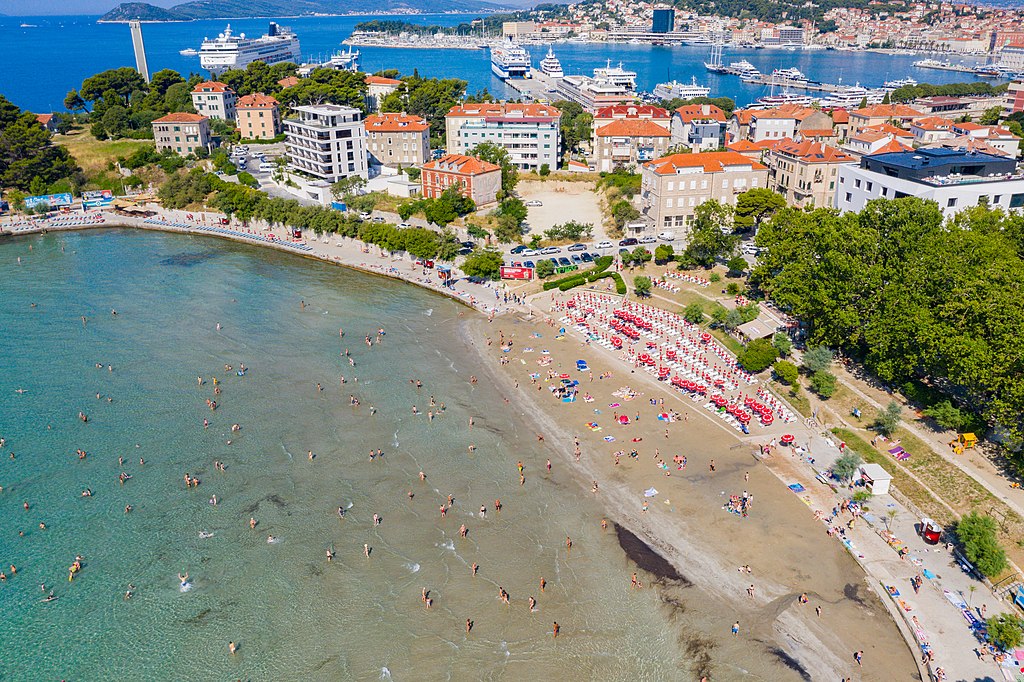
Photo by dronepicr from Wikimedia Commons
Although not a lot of new buildings are built within the historic center, a few modern areas have changed in recent decades. The Bačvice neighborhood with its popular beach and waterfront park is known for being a lively scene with bars, restaurants, and popular nightlife. Marjam Hill, a large limestone hill located East of the city, is also a popular tourist destination for its untouched wilderness. The hill also showcases a few Cliffside churches which are several centuries old.
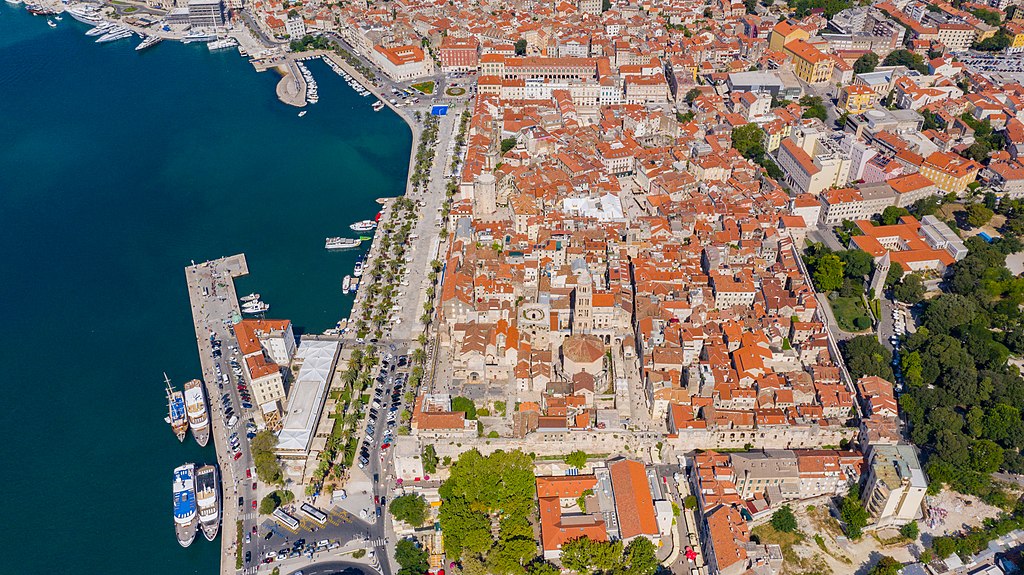
Photo by dronepicr from Wikimedia Commons
Conclusion
Along with many other cities along Croatia’s Dalmatian Coastline, Split is an incredible city filled with history, culture, and exquisite architecture. Split’s historic center and the Palace of Diocletian have been listed as UNESCO World Heritage Sites since 1979.
From its unorthodox beginnings as a fortified Roman Palace, to its medieval expansion, to the modern metropolis that it is today, Split is truly a worthy travel destination. The architecture of Split is eclectic and shows how the city changed hands constantly throughout history. Split contains some of the best Roman sites outside of Rome, some of the best Venetian Architecture outside of Venice, and a multitude of other historic buildings that are worth exploring.
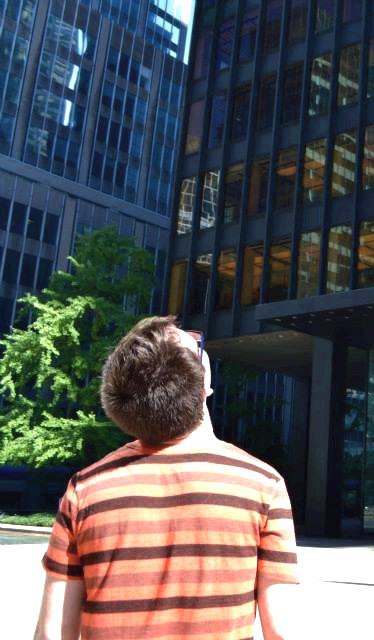
- About the Author
- Rob Carney, the founder and lead writer for Architecture of Cities has been studying the history of architecture for over 15 years.
- He is an avid traveler and photographer, and he is passionate about buildings and building history.
- Rob has a B.S. and a Master’s degree in Architecture and has worked as an architect and engineer in the Boston area for 10 years.
Like Architecture of Cities? Sign up for our mailing list to get updates on our latest articles and other information related to Architectural History.

Photo by LBM1948 from Wikimedia Commons
